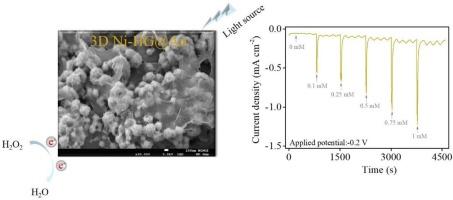基于三维Ni-graphene@au骨架分层结构的可见光辅助光电化学传感平台用于人血清中H2O2检测
IF 4.1
3区 化学
Q1 CHEMISTRY, ANALYTICAL
引用次数: 0
摘要
过氧化氢(H2O2)是活性氧(ROS)中的一种,与肿瘤的发生和发展密切相关,因此敏感、准确的检测对疾病的早期诊断至关重要。在这项研究中,等离子体金纳米颗粒被整合到一个相互连接的三维多孔Ni -石墨烯框架中,以构建分层的Ni - graphene@Au导电骨架。该材料通过简单的一步电沉积法合成,提高了H2O2检测的效率和灵敏度。该结构作为光电传感平台,利用金纳米粒子的强局部表面等离子体共振(LSPR)效应,实现了等离子体激发下的高效光收集,显著提高了光电电化学性能。lspr活性金纳米粒子与高导电性三维多孔ni -石墨烯网络之间的协同相互作用产生了增强,这提供了扩大的光电活性表面积,并促进了快速电荷传输。在光辅助条件下,Ni - graphene@Au传感器对H2O2检测表现出强烈的光电催化响应。当应用于稀释的人血清样品时,该传感器在0.1-1.0 mM范围内提供线性响应,具有出色的灵敏度(0.1197 mA mM−1 cm−2)和低检测限(33.5 μM)。演示的性能突出了在真实生物环境中优越的分析能力。总的来说,Ni - graphene@Au结构出色的光电化学性质表明,在临床应用中,特别是在早期疾病诊断中,H2O2传感具有很强的潜力。本文章由计算机程序翻译,如有差异,请以英文原文为准。

Visible light-assisted photoelectrochemical sensing platforms based on the hierarchical architectures of 3D Ni-graphene@au skeletons for H2O2 detection in human serum
Hydrogen peroxide (H2O2), one of the reactive oxygen species (ROS), is closely linked to carcinogenesis and tumor progression, making sensitive and accurate detection essential for early disease diagnosis. In this study, plasmonic Au nanoparticles were integrated into an interconnected 3D porous Ni–graphene framework to construct hierarchical Ni–graphene@Au conductive skeletons. The material was synthesized through a simple one-step electrodeposition method to improve both efficiency and sensitivity of H2O2 detection. The engineered architecture functions as a photoelectrochemical sensing platform, where the strong localized surface plasmon resonance (LSPR) effect of Au nanoparticles enables efficient light harvesting under plasmonic excitation and significantly enhances photoelectrochemical performance. Enhancement arises from the synergistic interaction between LSPR-active Au nanoparticles and the highly conductive 3D porous Ni–graphene network, which provides an enlarged photoelectroactive surface area and facilitates rapid charge transport. Under light-assisted conditions, the Ni–graphene@Au sensor exhibited a strong photoelectrocatalytic response toward H2O2 detection. When applied to diluted human serum samples, the sensor delivered a linear response in the 0.1–1.0 mM range, with excellent sensitivity (0.1197 mA mM−1 cm−2) and a low limit of detection (33.5 μM). The demonstrated performance highlights superior analytical capability in real biological environments. Overall, the outstanding photoelectrochemical properties of the Ni–graphene@Au architecture indicate strong potential for clinical implementation in H2O2 sensing, particularly for early disease diagnosis.
求助全文
通过发布文献求助,成功后即可免费获取论文全文。
去求助
来源期刊
CiteScore
7.80
自引率
6.70%
发文量
912
审稿时长
2.4 months
期刊介绍:
The Journal of Electroanalytical Chemistry is the foremost international journal devoted to the interdisciplinary subject of electrochemistry in all its aspects, theoretical as well as applied.
Electrochemistry is a wide ranging area that is in a state of continuous evolution. Rather than compiling a long list of topics covered by the Journal, the editors would like to draw particular attention to the key issues of novelty, topicality and quality. Papers should present new and interesting electrochemical science in a way that is accessible to the reader. The presentation and discussion should be at a level that is consistent with the international status of the Journal. Reports describing the application of well-established techniques to problems that are essentially technical will not be accepted. Similarly, papers that report observations but fail to provide adequate interpretation will be rejected by the Editors. Papers dealing with technical electrochemistry should be submitted to other specialist journals unless the authors can show that their work provides substantially new insights into electrochemical processes.

 求助内容:
求助内容: 应助结果提醒方式:
应助结果提醒方式:


